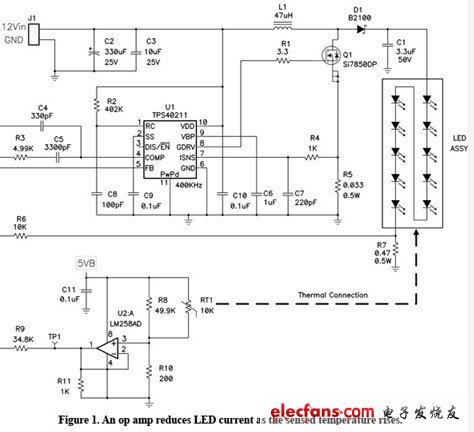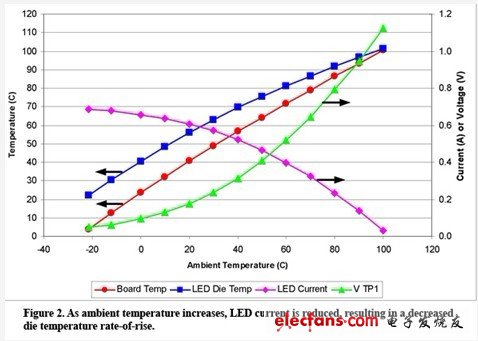The use of LEDs for high-brightness illumination requires the use of the maximum current drive allowed by the manufacturer, but the average life of the LED is highly dependent on the operating temperature. A 10°C increase in operating temperature can reduce its life by half. This situation forces the designer to reduce the regulation current and sacrifice brightness to extend the life. If the LED is required to operate at a higher ambient temperature, the current must be further reduced to minimize the ambient to chip temperature rise to ensure a long life. However, due to the upper temperature limit, this will reduce the illumination brightness in the low to medium ambient temperature range. Essentially, we work in high temperature environments by reducing the brightness. Figure 1 shows an LED driver circuit that uses a thermistor to control an operational amplifier (op amp) that reduces the drive current as the LED board temperature rises.

Figure 1 The op amp reduces the LED current when the temperature rise is detected.
The LED array current is adjusted by detecting the voltage of the current detecting resistor R7 and used as a feedback control of the controller, for example, TPS40211. The op amp circuit (including R9) injects a current into the feedback node (FB) to reduce the regulation current or sink its current to increase the regulation current. The FB node voltage is kept constant at 0.26V. Increasing the voltage at the op amp output (TP1) must be compensated by lowering the R7 voltage to reduce the LED current. When the op amp output is just 0.26V, the injection current is zero and the LED regulation is unaffected.
The thermistor RT1 is a negative temperature coefficient (NTC) device. Its nominal resistance is 10K ohms at 25°C, but increases above 300K ohms at –40°C and below 1K ohms at 100°C, and is in a non-linear manner. Resistors R8 and R10 turn the 5V bias voltage down to the FB voltage, while the value of R9 controls how quickly the current decreases with high temperature. It is important to use a well-adjusted bias voltage because the accuracy of the circuit is affected by the bias tolerance. Resistor R9 must be placed as close as possible to the current mode boost controller in order to minimize noise sensitivity. Using a thermal epoxy, connect the thermistor RT1 as close as possible to the central LED on the PWB.
Figure 2 shows the data obtained under various temperature conditions. Only LEDs and thermistors work in this temperature range. The temperature detected by the thermistor is plotted as a graph compared to the ambient temperature. We also plot the calculated LED chip temperature, which is equal to the board temperature plus the power of each LED multiplied by the junction to chassis thermal impedance (8 ° C / W). We can see that under high ambient temperature conditions, the op amp circuit reduces the LED current while the LED chip temperature is close to the LED board temperature. In this case, the LED board temperature is close to the ambient temperature because the LED current is almost zero. In this way, the temperature of the LED chip can be stabilized without change. RT1 nonlinearity is responsible for the sharp change in LED current at the highest temperature. The temperature "control voltage" of TP1 is also plotted and closely matches the expected value.

Figure 2 The ambient temperature rises and the LED current decreases, resulting in a lower die temperature rise rate.
to sum up
In high-temperature environments, the use of high-power LEDs can degrade LED brightness and shorten the lifespan. In this case, the thermal feedback circuit is very useful. It reduces the LED current, which reduces the power consumption of the LED and ultimately reduces the temperature rise of the LED. Since LED brightness decreases with temperature rise, this approach may not be practical in some applications that require constant brightness. However, this circuit can extend the useful life of the LED in extreme environments.
220V 25*15Cm Led Neon Flex,Ledvance Neon Flex,Neon Flex Strip Light,Led Neon Flex Light
NINGBO SENTU ART AND CRAFT CO.,LTD. , https://www.sentuledlight.com
